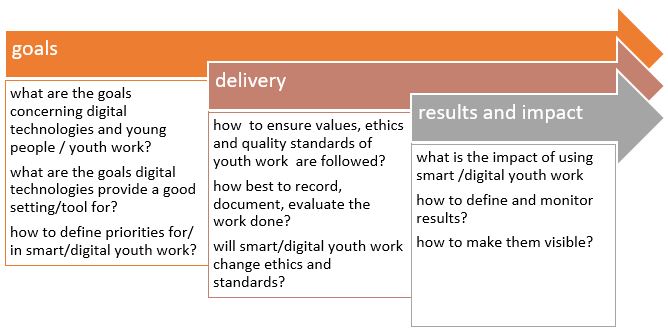Digital Youth
3.4. Note on the quality of smart youth work
Discussing smart youth work and digital youth work, also work with and services for young people in general, the question “what are the objectives and results” is more and more important.
All areas of public services are dealing with the issues of how to efficiently and with high quality reach the goals, but also how to publicly and visibly show evidence of those results and impact. Cross-sectoral and the whole-of-the-government approach[1], which are increasingly relevant for public sector in many countries in Europe, add another layer to the need for well-designed and well-aimed policies and their implementation.
When talking about youth policies and youth work, the issues of defining and measuring quality, also describing and proving results and impact have been discussed for a long time. The longevity of these discussions has among other things to do with the difficulties they pose.
Many of those difficulties (maybe also the most important ones) are connected with the question of formulating and communicating clear and relevant set of aims and objectives both for the policies and for the everyday practice. Also with describing the high–quality practice that should lead to achieving the goals. In youth work, there are many different approaches among and inside the countries in Europe on what are the aims and objectives (defined and/or used in practice). Also, what are the practices – methods, formats etc to do the work that “is working” in relation to those aims. Considering this variability there is also a great many ways on how to define the quality of youth work and how to measure it.
When discussing smart and digital youth work, there is an understanding that it is and should be part of the same set of goals and values as youth work in general. However when we come to the question what is quality in connection digital youth work and how to measure and ensure it, the difficulties faced in designing the chain of aims-objectives-methods-indicators-results for youth work, are most likely to repeat themselves. As digital technologies are constantly evolving and changing, the difficulties are even more complex.
Some questions on the way to discussiong quality in smart and digital youth work:

[1] The relevance to the youth policy is best described in the OECD report on youth policy (2018) http://www.oecd.org/gov/youth-stocktaking-report.pdf

